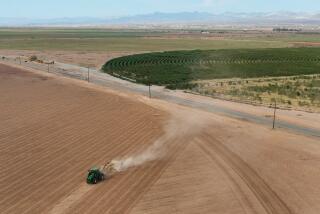El Nino to Send More Rain, Scientists Say
- Share via
A fresh surge of sun-warmed water from the western Pacific Ocean is poised to revive the El Nino phenomenon off South America, indicating that the western United States can expect continued wet weather in March and possibly next winter as well, American and French scientists said Friday at the Jet Propulsion Laboratory in Pasadena.
Using a U.S.-French satellite called Topex-Poseidon that maps sea-surface heights to within one inch while orbiting 830 miles overhead, the scientists tracked the warm water as it spread from southeast of the Philippines in December toward South America at a steady 6 m.p.h.
The latest warm water surge, called a Kelvin wave, is just now starting to arrive in waters off Ecuador and Peru, where it is resupplying the warm water El Nino phenomenon that regularly alters weather patterns across North America and, to a lesser extent, around the world.
El Nino is blamed for unusually cold winters in eastern North America, drought in Africa and Indonesia, and hot, dry summers in Europe, said French scientist Jean-Francois Minster.
Other scientists recently said they had noticed some flagging in the strength of the most recent manifestation of El Nino, named for the Christ child because it was first observed late one December. Dispersion of the warm El Nino water would have meant an end to the winter storms that are pounding California and probably a milder winter next year. But this new evidence contradicts that forecast.
Jim Mitchell of the U.S. Naval Research Laboratory in Mississippi said this surge is not as big as those that triggered severe El Ninos in 1982-83 and 1986-87, but is as big as the surge in January, 1992, that marked the beginning of the current El Nino cycle. Thus, it may extend this El Nino through March and may be enough to repeat its weather effects next winter.
The Topex-Poseidon satellite can measure warm water because water expands when warm, raising parts of the ocean several inches above cooler waters nearby. The satellite’s radar altimeters measure this difference--after factoring out waves and tides--by timing how long it takes radar pulses to bounce off the ocean surface.
Key to the satellite’s accuracy is a precise orbit. Byron Tapley, who works on the project, said that three independent tracking systems keep the satellite within two inches of its 830-mile-high orbit at all times.
Topex-Poseidon’s long-range mission is to chart the marine equivalents of atmospheric high- and low-pressure cells, said scientists at JPL, which is co-managing the project with the French National Center for Space Studies. This may eventually permit scientists to forecast ocean conditions the way meteorologists forecast atmospheric weather.
National Aeronautics and Space Administration Project Manager Lee-Leung Fu said the two kinds of forecasting are related because ocean conditions greatly influence the weather. For example, Northern Europe, at the same latitude as the Yukon, enjoys temperate weather largely because of the heat transferred from the Caribbean to the North Sea by the Gulf Stream.
“For the first time, ocean currents can be mapped from space with sufficient accuracy to let scientists measure their impact on weather and climate,” Fu said.
More to Read
Sign up for Essential California
The most important California stories and recommendations in your inbox every morning.
You may occasionally receive promotional content from the Los Angeles Times.










